Time quickly running out for Mt. Namsan’s ancient archery field
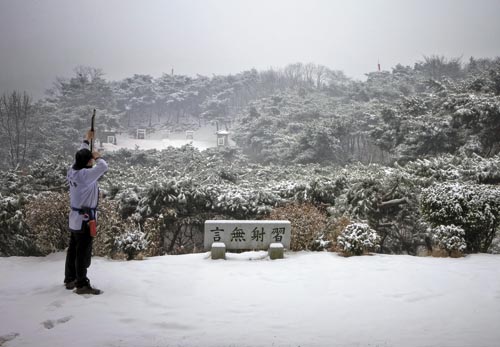
An archer practices at Seokhojeong, Mount Namsan, Seoul, after a light dusting of snow. The city is planning to move the centuries-old archery grounds to make room for hiking trails. By Kwon Hyuk-jae
If everything goes according to the Seoul Metropolitan Government’s plan, bulldozers will be sent in later this year to flatten the over 300-year-old Seokhojeong archery field on Mount Namsan to make room for more jogging paths.
Seokhojeong is Korea’s national archery field. And in a country where archery follows only football in popularity, the government’s plan to uproot the ancient grounds and move it 10 kilometers north to Eunpyeong District has some citizens up in arms.
In 2009, the Seoul Metropolitan Government announced the Namsan Renaissance Project, a $205 million plan to create 7.5 kilometers (4.7 miles) of scenic paths on the popular mountain. Seoul’s rationale for moving Seokhojeong is that it would be an eyesore for joggers.
“Mount Namsan got its name in 1940 and Seokhojeong has been an archery field for civilians for more than 300 years. Although damaged during wars, it was reconstructed by residents in the 1970s,” said Professor Na Young-il of Seoul National University. “Relocating Seokhojeong, a site of such historical significance, is ridiculous.”
Seoul National University and the Jung District Office held a public hearing in January at the Chungmu Art Hall. However, Seoul has refused to reconsider its expensive redevelopment plans.
To honor archery in Korea and the history of Seokhojeong, the JoongAng Ilbo takes a look at Korean archery and spotlights a diverse group of archers in the country.
Archery in Korea
Koreans categorize archery into two styles - gukgung (Korean archery) and the modern, Western-style yanggung. Yanggung differs from gukgung in both equipment and distance. While yanggung archers have a maximum shooting range of 90 meters (295 feet) and use a sight, gukgung archers do not use one and have a maximum range of 145 meters.
While yanggung is the most popular form of archery globally, gukgung is as popular as ever in Korea. The number of gukgung fields owned by the Korea National Archery Association last year was 350.
In fact, archery is Korea’s second-most popular sport, after only football in terms of the number of people who take it up. According to data provided by SNU’s Na, the number of yanggung archers registered with the Korean Olympic Committee totaled 1,559 last year, along with 11,560 gukgung archers.
It is no surprise that Korean archers nowadays dominate international tournaments, from last year’s Guangzhou Games in China, where Korean men won their eighth consecutive Asian Games gold, to the Beijing Games, where Korea left with five medals.
American pleads for field’s preservation
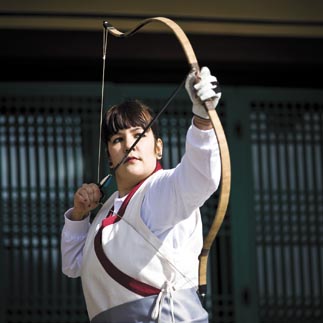
Alejandra Gallo Yee, from the United States, became obsessed with archery after watching the historical drama “Jumong.”
The JoongAng Ilbo met up with the 30-year-old at Seokhojeong archery range on Mount Namsan, central Seoul.
Yee said she was a big fan of Korean dramas and Korean pop even before she came to Korea.
She developed an affection for archery after watching the historical drama “Jumong,” which starred Song Il-gook.
“After watching scenes from Jumong, I knew exactly why Koreans always win gold medals at international archery tournaments,” she said.
Once she learned that her husband would be transferred to Korea, Yee researched Korean archery online.
Soon after arriving here, she took up the sport and succeeded in hitting her first bull’s-eye after only four months of training.
Ali will return to the United States next year with her bow.
“I plan to create an archery field back in the United States. I hope to continue Korean archery with my husband even after we return,” she said.
Last month, after finding out that the Seoul Metropolitan Government has been planning to relocate the over 300-year-old Seokhojeong archery field, Ali said she felt compelled to take action.
She participated in a public hearing for the relocation of Seokhojeong at Seoul Chungmu Art Hall.
“I hoped that I could at least contribute to helping preserve Seokhojeong on Namsan by participating,” Yee said.
She added: “Please remember that a lot of foreigners who visit Namsan also learn about Korea’s national archery as well.”
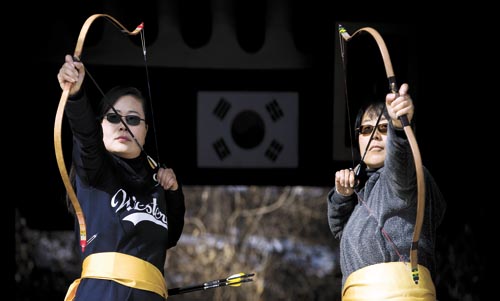
Lee Hee-suk (left) and Lee Eun-jeong go to Hwanghakjeong in Jongno District every weekday.
For Lee sisters, archery is better than men
Two talented women in the world of archery can be found at Seoul’s busiest gukgung field, Hwanghakjeong, in Jongno District, central Seoul.
Sisters Lee Hee-suk, 45, and Lee Eun-jeong, 39, are what Koreans refer to as a “Gold Miss” - a.k.a. highly educated, successful, unmarried women in their 30s and 40s.
The sisters said gukgung is better than men. They gave two reasons: First, archery is good for your body. It requires a lot of strength and a trained posture, they said.
“The way you stand upright with every muscle in your body tensed, it makes your body stronger and can even prevent all kinds of ailments such as urinary incontinence,” said Eun-jeong.
Second, Eun-jeong said archery never lies. If an archer’s arrow fails to meet the bull’s-eye, it is entirely the archer’s fault. When an archer’s arrow misses its mark, it is a reflection of the archer’s mind, according to the women. This is the reason Eun-jeong said she only blames herself whenever she turns in a poor performance.
“You need to have strong legs to maintain the purposeful postures required to hold certain angles in gukgung,” said Eun-jeong.
For the past two years, the Lee sisters have come to Hwanghakjeong every day at 7 in the morning.
The sisters are a rarity at Hwanghakjeong. Young single women and gukgung normally don’t mix, as gukgung tends to be enjoyed mostly by retirees.
The sisters first encountered gukgung in 2009 when they visited Hwaseong Fortress in Suwon, Gyeonggi. After paying 2,000 won ($1.77) to shoot 10 arrows at a target, they fell in love with the sport.
Soon after, they joined classes at the National Folk Museum of Korea, where they learned the history of gukgung. Next, they bought a bow and joined Hwanghakjeong. This marked the start of their special relationship with the sport.
Park Jin of the Grand National Party
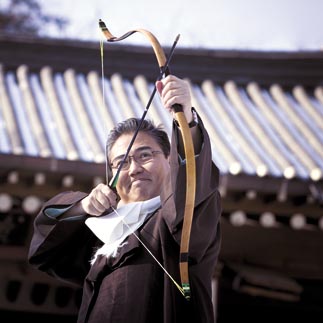
Park Jin of the Grand National Party
“I first came to Hwanghakjeong during an event in 2007. I will never forget how good I felt after I picked up my first bow,” he said.
After successfully campaigning for a National Assembly seat in the 2008 elections, Park wasted no time getting back to Hwanghakjeong archery field .
Park said that archery is similar to golf. Both sports require a sensitive touch; results can differ greatly from day to day, and both require plenty of concentration.
“The delicate body positioning required for archery helps in gaining strength and losing belly fat. My goal for this year is to succeed in hitting a bull’s-eye five times in a row,” said the lawmaker.
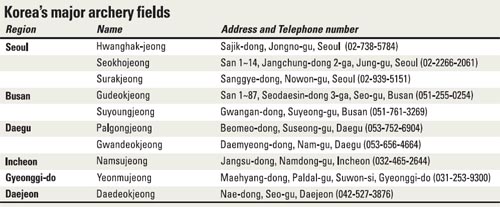
There are seven gukgung fields in Seoul and another 343 nationwide that belong to the Korea National Archery Association. Anyone who registers for membership is granted access.
Annual membership ranges from 200,000 won ($177) to 1 million won, while monthly membership is from 20,000 won to 40,000 won.
Before firing their first arrows, members are required to go through a training course.
Gukgung equipment is available for rent with one-on-one classes, but beyond that, members are responsible for purchasing their own equipment. There are two types of bows - traditional and customized. Traditional bull horn bows cost 600,000 won, while those customized to the archer’s size cost 200,000 won. Arrows cost 70,000 won for 10.
Korean archery has ratings ranging from level 1 to level 9. Archers above level 5 are considered expert.
The Korea National Archery Association holds an annual contest for those who wish to upgrade their level. The distance between the archer and the target is regulated at 145 meters (476 feet). The target is 2 meters in width and 2.66 meters in length.
*For more information, visit the Korea National Archery Association’s Web site, http://kungdo.sports.or.kr.
By Seo Ji-young, Chang Hae-won [estyle@joonang.co.kr]
Related Korean Article[중앙일보]
여성·국회의원·미국인도 “국궁은 내 친구”
현재 국궁 인구는 3만 명으로 추산된다. 많은 편이라고는 할 수 없다. 근근이 이어져 내려온다는 표현이 정확하다. 그나마 요즘 들어 국궁 인구가 늘고 있다는 소식이다.
서울 황학정의 변용범 이사는 “레저에 대한 사회적 관심이 증가하면서 국궁 인구도 꾸준히 증가하는 추세”라고 말했다. 어르신 중심의 동호회는 물론이고 대학생·외국인까지 사정을 수시로 들락거린단다. 국궁의 매력에 흠뻑 빠져 산다는 세 사람을 소개한다.
[자매 궁사 이희숙·이은정]
[건강하고 정직해서 남자보다 좋아요]
서울 황학정에는 골드미스 자매가 있다. 자매 화가 이희숙·은정씨다. 자매는 이태째 매일 아침 7시 황학정에 출근한다.
사실 국궁과 미혼 여성은 어울리는 조합이 아니다. 국궁 인구 대부분이 노년층이다. 전국 활터 중에서 가장 사람이 많아 ‘국궁 1번지’로 통하는 황학정에서도 미혼 여성은 좀처럼 보이지 않는다.
자매는 2009년 수원 화성에 놀러 갔다가 생전 처음 활을 만졌다. 2000원 내고 활 열 발을 쏘는 국궁 체험을 했던 것이다. 그 열 발의 추억이 이후 자매의 생활이 바뀌었다. 활쏘기에 빠져든 자매는 서울 국립민속박물관 국궁 교실에 참가해 국궁의 역사를 배웠고, 내친 김에 개량궁을 샀다. 그리고 황학정으로 달려갔다. 그날부터 자매의 황학동 출근이 시작됐다.
자매는 남자보다 국궁이 더 좋다고 입을 모은다. 자매가 밝힌 국궁이 남자보다 더 매력적인 이유 두 가지를 소개한다. 첫째, 활은 건강하다. 활쏘기는 많은 힘이 필요하다. 초심자의 경우 시위를 끝까지 잡아당기기도 버겁다. 정(丁) 자꼴도 아니고 팔(八) 자꼴도 아닌 각도를 뜻하는 비정비팔(非丁非八) 자세를 갖추려면 특히 하체가 튼튼해야 한다. 은정씨는 비정비팔 자세가 요실금 예방에 효과 만점이라고 귀띔한다. “서 있기만 해도 항문을 꽉 조여주거든요.”
둘째, 활은 정직하다. 화살이 생각한 곳에 꽂히지 않는 건 전적으로 사람 잘못이다. 서 있는 자세가 잘못됐거나 과녁을 똑바로 겨누지 못했기 때문이다. 그러니까 화살이 꽂히는 지점은 사람의 마음 상태를 낱낱이 드러내는 증거다. 동생 은정씨가 활이 과녁의 변죽만 때리면 먼저 자신의 잘못부터 돌아보는 까닭이다.
[국회의원 궁사 박진]
[집중해야 해요, 골프와 많이 닮았죠]
“어이쿠, 관중 하셨습니다. 축하합니다.”
서울 사직동 황학정. 1898년 고종 황제가 경희궁에 개장했다가 일본이 쫓아내자 1922년 지금의 사직공원 뒤편으로 이전한 활터다. 이 유서 깊은 활터에 회색 적삼을 입은 남자가 나타났다. 남자가 3번 사대에 자리를 잡았다. 잠시 숨을 고르는가 싶더니 곧바로 거궁 자세를 취했다. 짱짱하게 당겨진 시위를 놓자 화살이 날쌔게 겨울 공기를 갈랐다. 부드러운 곡선이 하늘에 그려졌다. “쿵”. 스피커에서 관중했을 때 과녁에서 울리는 소리가 터져나왔다. “정확하게 꿰뚫었네요. 축하합니다.” 주위에 있던 궁사들이 예를 갖춰 인사했다. 관중한 남자의 얼굴에 미소가 그려졌다. 박진 한나라당 의원이었다.
박 의원은 2008년 초 처음 입사했다. “2007년께 황학정 행사 때 처음 왔습니다. 시위를 잡을 때 팽팽한 감촉이 좋더군요.” 이듬해 4월 총선이 끝난 뒤 사정을 다시 찾았고, 이후 주중 새벽 시간에 나와 꾸준히 시위를 당겼다.
그는 활쏘기와 골프가 많이 닮았다고 말했다. 두 운동 모두 대단히 민감한 운동이고, 당일 컨디션에 따라 결과가 크게 달라져서다. 골프공과 골프채에 집중해야 좋은 샷이 나오듯이 활과 과녁에 마음을 쏟아야 관중도 가능하다. 간편함에 있어서는 활쏘기가 낫다. 골프는 시간도 많이 걸리고 사람도 네 명을 맞춰야 하지만 국궁은 그런 게 필요 없다. 언제든 가까운 사정에 나가 활을 쏘면 된다. 장비도 골프에 비해 훨씬 싸고 가볍다.
“발시 할 때 끝까지 시위 맥을 놓지 않습니다. 활이 빗나가는 것을 막기 위해서지요. 이 동작을 반복하면 단전에 힘이 생기고 뱃살도 빠집니다. 올해는 궁사로서 소박한 목표도 있습니다. 5발 연속 관중을 성공하는 ‘몰기’입니다.”
[미국인 궁사 알리]
[주몽 속 한국 활 보고 반했어요]
깊은 흑갈색 눈동자였다. 바람에 흩날리는 머리카락 사이로 하얀 피부가 도드라졌다. 그의 이름은 알레한드라 갈로 이. 사람들은 그를 ‘알리’라 부른다. 알리는 미군인 남편을 따라 지난해 1월 한국에 왔다. 서울 남산 석호정에서 만난 이국인은 활을 품에 안고 있었다. 하얀색 개량 저고리 갖춰 입고 허리에 궁대를 묶은 모습이 제법 어울렸다.
“한국 드라마와 한국 아이돌 음악 ‘광팬’이었어요.”
알리가 처음부터 한류 매니어는 아니었다. 알리가 미국에 살 때 어느 날 여동생이 놀러왔다. 동생은 가수 비가 주연한 한국 드라마 ‘풀하우스’를 열심히 시청했고 알리도 함께 보기 시작했다. 그게 발단이 됐다. 주인공이 가수란 걸 알고 난 뒤에는 한국 가요로 관심 영역을 넓혔고 ‘풀하우스’가 끝난 뒤에는 ‘주몽’으로 갈아탔다. “주몽이 활 쏘는 장면을 보며 한국 양궁이 늘 금메달을 따는 이유를 알았어요.” 남편이 한국 발령을 받자마자 알리는 인터넷 검색 창에 ‘한국 활’을 쳤다. 한국에 오자마자 두 달간 국궁을 배웠고, 그로부터 두 달 뒤 첫 관중(貫中·화살을 과녁 한복판에 맞히는 것)에 성공했다.
알리는 이르면 내년 미국으로 돌아간다. 활도 들고 갈 생각이다. “미국에서 활터를 만들 생각이에요. 남편과 함께 한국 활을 쏘고 싶어요.”
알리는 지난달 20일 서울 충무아트홀에서 열린 ‘석호정 존치를 위한 공청회’에 참석했다. “서울시가 석호정을 다른 데로 옮길 것이라는 얘기를 듣고 석호정을 남산에 보존하는 데 조금이라도 도움이 될까 싶어 나갔어요. 많은 외국인이 남산을 왔다가 국궁도 알고 간다는 사실을 꼭 기억해 주세요.”










with the Korea JoongAng Daily
To write comments, please log in to one of the accounts.
Standards Board Policy (0/250자)